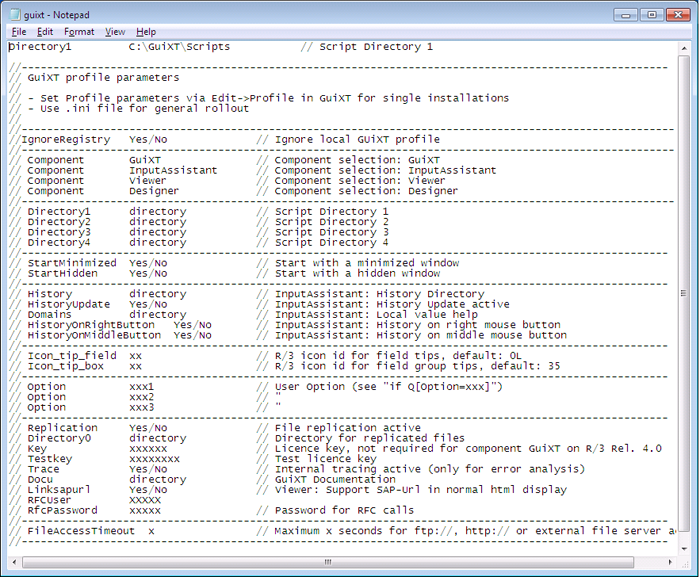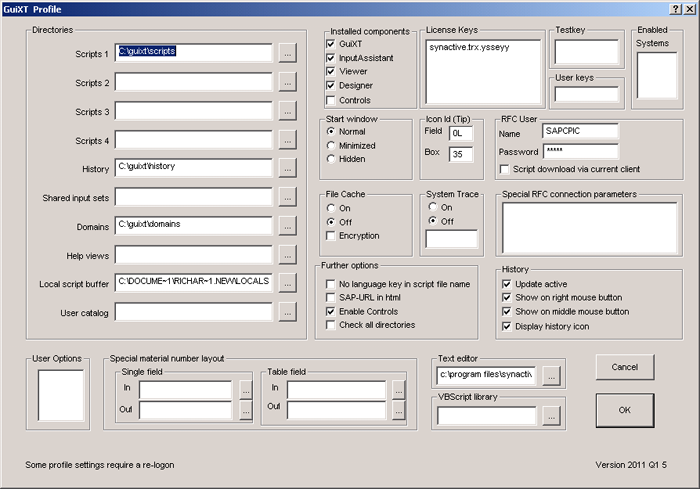This section covers the configuration for GuiXT. Topics covered are as follows:
GuiXT is configured through the GuiXT.ini file that we introduced previously. In this section, we will discuss the GuiXT.ini file and define the parameters contained within it. A typical GuiXT.ini file appears as follows:

There are many parameters that are contained in a GuiXT.INI file. These are defined as follows:
The GuiXT.ini file can be edited in two different way, as follows:
The quickest method of changing parameters in GuiXT is to edit the GuiXT.ini file. To edit the GuiXT.ini file, users can employ any text editor. In our examples, we are using the default Windows editor Notepad. This file is explained in detail above and is located in the following directory:
C:\Program Files\SAP\FrontEnd\SAPgui\
In the GuiXT window, press the Profile button or go to the Edit menu and select Profile. A new window will open, as shown below:

In the Profile window, set the following parameters:
In addition to the above required parameters, there are other parameters that can be modified in the Profile window. These are explained in the GuiXT.ini File section above.
As was previously discussed in the Profile section above,, it is possible to activate different script directories on different user systems. However, this is not always sufficient, as there are scenarios where simply specifying the scripts as being assigned to a specific machine may not be the best option. for example, if a user works on multiple systems, it is better to define the relevant scripts based on the user's SAP identity. Similarly, if a user prefers a single standard (and central) configuration for managing scripts, then the user catalog is the best choice. By using a group catalog, it is possible to select not only specific script directories, but also to designate both systems and group directories upon which those scripts will act. User catalogs are read after the SAP login screen - for the login screen itself, the listed directories in the guixt.ini file will apply. The syntax for creating a user catalog in the guixt.ini is as follows.
UserCatalog \\ServerName\GuiXT\DatabaseName\usercatalog.txt
In this example, there is an entry in the guixt.ini file that will specify a the user catalog. It is possible to replace the 'DatabaseName' portion of the path with a variable, as shown below. This will allow for different user catalogs to be applied to different production systems.
UserCatalog \\serverName\GuiXT\&database\usercatalog.txt
It is possible to store a user catalog file on a Web server. In this case, users can specify the location as shown in the following example:
UserCatalog http:////www.mycompany.com/guixt/usercatalog.txt
Each user catalog contains up to five groups, which are named as the following:
Each group can have up to four script directories specified. If the directory names contain spaces, it is necessary to designate them as strings by using double-quotes, as in the following example:
Directory1 "\\server\guixt\Directory Name"
Below the groups, there is a section where users can specify one group for each client or user. At the end of each client, users can specify the correspondence for all remaining users by adding 'client/*'. If it is necessary to list a client-independent association, add an asterisk '*' to the end of the given catalog. It is not necessary to list users in alphabetical order, but doing so will aid list maintenance, so it is recommended. If the specification 'none' is used with a directory name, it designates that the given directory is not active even if it is specifically referenced.
Modifications in a user catalog become active on the user's first login after the changes have been applied. If a user catalog is changed while a session is active, the changes will only take effect on the users' subsequent login - they will not affect any current sessions.
If a particular user is not found in the user catalog, then the system will first look to see if there is a general notification. If there is a '*' entry, the system will use the corresponding groups. If no such designation exists, then the system will use any default directories that are specified in the guixt.ini file.